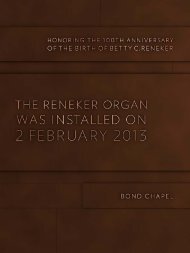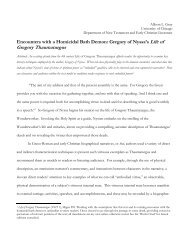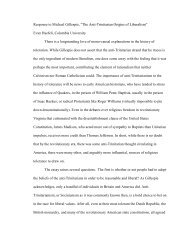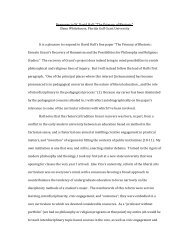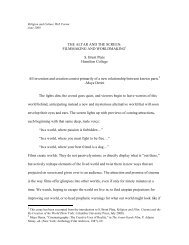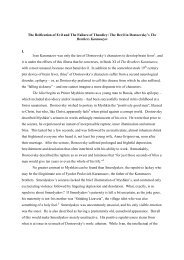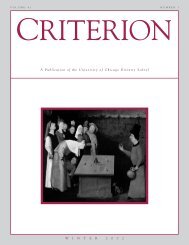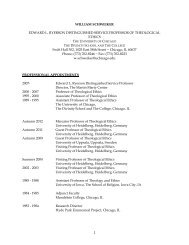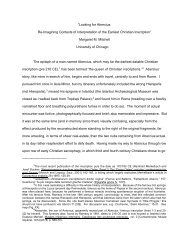Housing the Dead: the tomb as house in Roman Italy - Divinity School
Housing the Dead: the tomb as house in Roman Italy - Divinity School
Housing the Dead: the tomb as house in Roman Italy - Divinity School
You also want an ePaper? Increase the reach of your titles
YUMPU automatically turns print PDFs into web optimized ePapers that Google loves.
8<br />
constitut<strong>in</strong>g him <strong>as</strong> a family member. The curse excludes him simultaneously from <strong>the</strong> gods of <strong>the</strong><br />
<strong>house</strong>, di penates, and <strong>the</strong> gods below, di <strong>in</strong>feri. The function of <strong>the</strong> <strong>tomb</strong> <strong>the</strong>n is to facilitate that<br />
l<strong>in</strong>k. The display of those united around <strong>the</strong> di penates, <strong>the</strong> family gods of <strong>the</strong> liv<strong>in</strong>g <strong>house</strong>, projects<br />
<strong>the</strong>ir unity <strong>in</strong>to <strong>the</strong> underworld, <strong>the</strong> <strong>house</strong> of <strong>the</strong> dead. In <strong>the</strong> end, Vesonius stands stripped to<br />
eternity of his pseudo-family, uncerta<strong>in</strong> what to display to <strong>the</strong> outside world, to <strong>the</strong> p<strong>as</strong>s<strong>in</strong>g hospes.<br />
But we should not shed a tear for him too h<strong>as</strong>tily. One of <strong>the</strong> most important features of Pompeian<br />
<strong>tomb</strong>s is <strong>the</strong> survival with<strong>in</strong> <strong>the</strong>m of <strong>in</strong>dividual headstones, called columellae, which often bear <strong>the</strong><br />
name of <strong>the</strong> buried. There were no less than 18 such headstones with<strong>in</strong> Vesonius’ <strong>tomb</strong>. Apart from<br />
himself and his patrona, Vesonia, we f<strong>in</strong>d a Vesonius Proculus, who died at 13, a Vesonia Urbana,<br />
who lived to 20, and a (H)eliodorus, who lived to 18. At this po<strong>in</strong>t we can only guess <strong>the</strong> story. The<br />
patrona sounds to have been his partner <strong>as</strong> well <strong>as</strong> former owner. Presumably <strong>the</strong>y are <strong>the</strong> parents<br />
of Vesonius Proculus and Vesonia Urbana. Heliodorus should be one of <strong>the</strong>ir slaves, <strong>as</strong> <strong>in</strong> all<br />
likelihood are <strong>the</strong> 13 o<strong>the</strong>r unnamed columellae, unless any of <strong>the</strong>m were freedmen. At le<strong>as</strong>t we can<br />
be confident Marcus Ofellius w<strong>as</strong> not among <strong>the</strong>m. The <strong>in</strong>terior of <strong>the</strong> <strong>tomb</strong> thus reconstitutes <strong>the</strong><br />
family so partially glimpsed on <strong>the</strong> exterior.<br />
To explore <strong>in</strong> detail this two-faced <strong>in</strong>ternal/external <strong>as</strong>pect of <strong>the</strong> <strong>tomb</strong> throughout <strong>Roman</strong> <strong>Italy</strong><br />
would stra<strong>in</strong> <strong>the</strong> limits of space and time of this paper. Instead, I wish to illustrate what seem to be<br />
<strong>the</strong> substantial changes over time of <strong>Roman</strong> practice by exemplify<strong>in</strong>g three moments: <strong>the</strong> first, a<br />
mid-Republican moment when <strong>Roman</strong> material culture still h<strong>as</strong> palpable l<strong>in</strong>ks to Etruscan practice,<br />
through <strong>the</strong> <strong>tomb</strong> of <strong>the</strong> Scipios; <strong>the</strong> second, a moment of late Republican/early Imperial transition<br />
seen through <strong>the</strong> necropolis of <strong>the</strong> Porta Nocera at Pompeii; <strong>the</strong> third, <strong>the</strong> high imperial tradition of<br />
<strong>the</strong> ‘<strong>house</strong>-<strong>tomb</strong>s’ of <strong>the</strong> metropolis seen through <strong>the</strong> <strong>tomb</strong> of Valerius Herma beneath St Peter’s. In<br />
each c<strong>as</strong>e, I shall risk overgeneralization through exemplification; but my <strong>in</strong>terest is underl<strong>in</strong><strong>in</strong>g <strong>the</strong><br />
substantial contr<strong>as</strong>ts across time <strong>as</strong> much <strong>as</strong> <strong>the</strong> cont<strong>in</strong>uities.<br />
The mid-Republic and <strong>the</strong> <strong>tomb</strong> of <strong>the</strong> Scipios<br />
The dearth of evidence from Rome of ei<strong>the</strong>r <strong>house</strong>s or <strong>tomb</strong>s predat<strong>in</strong>g <strong>the</strong> late Republic, coupled<br />
with <strong>the</strong> sharp imbalance <strong>in</strong> evidence from Etruria <strong>in</strong> <strong>the</strong> same period between abundant <strong>tomb</strong>s and<br />
scarce <strong>house</strong>s, h<strong>as</strong> long meant that Etruscan <strong>tomb</strong>s have had to work very heavily to supply <strong>the</strong> gaps<br />
<strong>in</strong> our knowledge of hous<strong>in</strong>g <strong>in</strong> both are<strong>as</strong>, and of <strong>tomb</strong>s <strong>in</strong> Rome. Carand<strong>in</strong>i’s excavations at <strong>the</strong><br />
foot of <strong>the</strong> Palat<strong>in</strong>e, coupled with <strong>the</strong> chance discovery of a suburban villa site beneath Renzo



